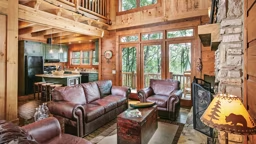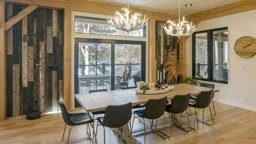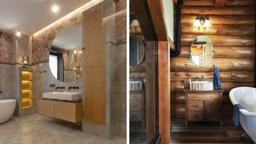
Many people who are planning a custom log home can picture it in their mind’s eye. However, pulling that vision out of your brain and accurately conveying it to a log home designer or independent architect can prove to be something of a challenge. Fortunately, it doesn’t have to be hard.
Michael Grant, a designer and principal with Modern Rustic Homes, has been helping people achieve their rustic home dreams for more than two decades. We picked his brain to demystify the design process and learn how to make the conversation between buyer and designer a fruitful exchange of ideas.
Q: How does the design process typically begin?
A: Picture this: A couple enters my company’s headquarters or visits my booth at a Log & Timber Home Show. The first question they ask is, “What do your log homes cost?” With all of the design options available in log home construction and no additional information (yet) from the couple, my response is, “I don’t know.” So I ask, “What are you planning to spend?” The couple says, “We don’t know.”
So now that this awkward exchange is out of the way, we can start to educate each other.
It’s common for prospective log homeowners to be able to convey how many bedrooms and bathrooms they need, as well as a ballpark number of square feet they want. But to truly get at the heart of the home’s design, we need to dig a bit deeper. These are a handful of the exploratory questions I ask that help me develop and refine a home’s design:
-
Do you want your house to span one, two or three levels?
-
What are the ages of the people who will be there most frequently?
-
What’s the topography of the build site, and do you live close to it?
-
Do you need a well?
-
Is power routed to the property?
-
Will this be a full-time residence or a vacation retreat?
-
Will it be used as a rental property?
-
Will you have a garage? If so, how many car bays do you need? Attached or detached?
-
How long will the driveway be?
-
Do you foresee a need for a residential elevator?
-
What type of amenities do you desire?
Then I ask them to describe their ideal architectural style and interior finishes. It’s not uncommon for a couple to have differing opinions on these points, but that’s where the benefits of working with a qualified designer really kick in. Good architects and designers are skilled interpreters and experts at merging styles so that a log home reflects each party’s unique style. They will be your partners throughout the journey. The payoff will be a well-designed, well-built, beautiful home.
Q: You mentioned the site’s topography is a key factor in a home’s design. Often, log homes are built on challenging mountainous terrain. What design advice would you give here?
A: The first step is to consider the ages, abilities and safety of those who will live there, as well as those who will visit.
As an example, I’m working with a young family from Naples, Florida, who wanted a mountain retreat to escape the heat and hurricanes. Their lot, chosen for the magnificent view of Petit Lake and the North Georgia mountains, is very steep. The sub-walls are 23 feet high, then there’s a 10-foot tall “basement” wall, and 11-foot-high main-level walls with vaulted ceilings. I advised the clients to think through the design. With three young boys, the house will be play-central for the kids and party-central for the adults. The terrace level (basement) is for the youngsters, with the main level for the grown-ups.
For everyone’s safety, we opted for 42-inch-high exterior railings (instead of standard 36-inch) with vertical balusters in a powder coated aluminum product. Because the porches and decks are so high, we also have a spiral staircase to ground level, if an emergency exit is needed.
Q: What other design considerations do you recommend for a multi-generational home?
A: Age-appropriate amenities and material selections are key. Referring, again, to the house in Naples, the materials we chose on the terrace level have been specified to withstand the wear and tear of kids at play and snack time: luxury vinyl plank (LVP) floors and quartz countertops are both waterproof and hygienic. The boys’ bedrooms boast built-in bunks, each equipped with a task light, power outlet and USB ports. The “game room” is outfitted with microwave oven, undercounter refrigerator, big-screen TV and plenty of room for board games, Ping Pong or pool tables.
The main level of this home provides a higher level of finishes, with European white oak floors, a beautiful stone fireplace with built-in bookcases and heavy timber rafter and beam ceilings.
Because it’s a family getaway, storage is a big deal. Plenty of consideration has been given to the pantry, laundry areas (each level has its own for convenience) and “toy” storage (e.g., mountain bikes, four-wheelers, kayaks and canoes).
Overall, the design is definitively modern rustic with a heavy emphasis on durable finishes, comfortable spaces and the ability to separate when needed.
Q: Often, a log home is a “forever” home — a reward for years of hard work and planning for the future. For a buyer on the brink of retirement, especially one looking to reduce maintenance and enjoy the home, what advice would you give?
A: If we are fortunate, with age comes wisdom and that drives many decisions toward convenience, comfort and casual living. We like quality things, great craftsmanship and the knowledge that our homes are well designed and well built. In the end, every homeowner wants a minimum of these three things:
-
A floor plan that supports and enhances daily life. Spaces that accommodate your lifestyle, the ability to age in place and ample display for the lifetime of collectibles, such as travel treasures and family photos. The capacity for one-level living is a must. (Should your property lend itself to a multi-level house, reserve the stairs for infrequently used spaces.) A major trend is to incorporate two primary suites on the main level; one for the owners and the other for anyone who cannot navigate stairs. The desire to age in place has also driven the increase in residential elevators in multi-level homes, which has proven to be a smart investment. Pantries are another top amenity. We simply want a stock of food items available should weather be formidable or, as we’ve seen in the past few years, shortages arise. Pantries also serve as a convenient place to store infrequently used small appliances or serving pieces. They have also become a secondary prep kitchen complete with a sink, disposal, refrigerator/freezer and often an additional dishwasher — this is often referred to as a “butler’s pantry.
-
Energy efficiency. This is easier to accomplish today than ever before. The use of spray foam insulation alone (often in the ceiling of a full-log home) will reduce energy consumption significantly. High SEER (Seasonal Energy Efficiency Rating) rated HVAC equipment, tankless water heaters and energy-efficient windows and doors each enhance a log home’s sustainability, even with high vaulted ceilings and lots of glass.
-
Minimal maintenance. Once you have made the decision to build that dream log home, the last thing you want to do is spend all your time on upkeep, right? Then design and build it right the first time. To keep maintenance low, I often specify a blend of natural and synthetic materials. Consider natural logs on the main level of the house where they are easily accessed for cleaning and a fiber-cement or PVC-based material in the gabled ends or dormers of the house that are difficult to reach. The synthetic materials hold paint well, often not needing reapplication for 20 years. Several siding manufacturers also offer prefinished materials that have excellent color fastness, adhesion and elasticity that look terrific and minimize maintenance. Another benefit of this mix of natural and synthetic materials is the added color and texture result in better curb appeal. For the logs, be sure to invest in an experienced stain contractor and exceptional products. In a bid to obtain work on your project, a contractor who’s unfamiliar with log homes may use an inferior product because it will be a third of the cost of a log-quality stain. Or the contractor may not understand how to properly clean the wood prior to applying the stain. If that’s the case, then you greatly increase the probability of mold or mildew growing behind the wood finish once it has been applied. So, a word to the wise: Make sure the wood is cleaned with bleach, oxalic acid or trisodium phosphate. Buy a quality wood stain, one with a mold or mildew inhibitor built in, if possible. And always follow the manufacturer’s directions.
These simple strategies work. My log home is 27 years old and has only been re-stained twice. Each spring after pollen season, I power wash the house to remove the dirt and debris that has accumulated, and my house looks new again.
Q: What’s your secret to success?
A: Two words: Experience and expectations. It all begins with establishing a good relationship with your log home supplier, designer and contractors. Be respectful. Set realistic expectations. Discuss the realities of building a home in today’s market of increased costs, high demand and limited labor. Keep it real and be kind. Perfection doesn’t exist. Challenges will arise but can be solved. Don’t make assumptions. Ensure you and your architect or designer do your homework so the builder can do his. With these principles as your solid foundation, the results will be exceptional.
Show and Tell
Once you’ve discussed your wants and needs wish list with your designer, back up your ideas with photographic examples of styles and features that appeal to you. Not only is a picture worth a thousand words, it may be a more accurate representation of what you’re looking for than a verbal description, as laypeople typically are
not well versed in design lingo. A folder, thumb drive or Pinterest board of ideas you’d like to include in your home will ensure you and your design team are speaking the same language.











